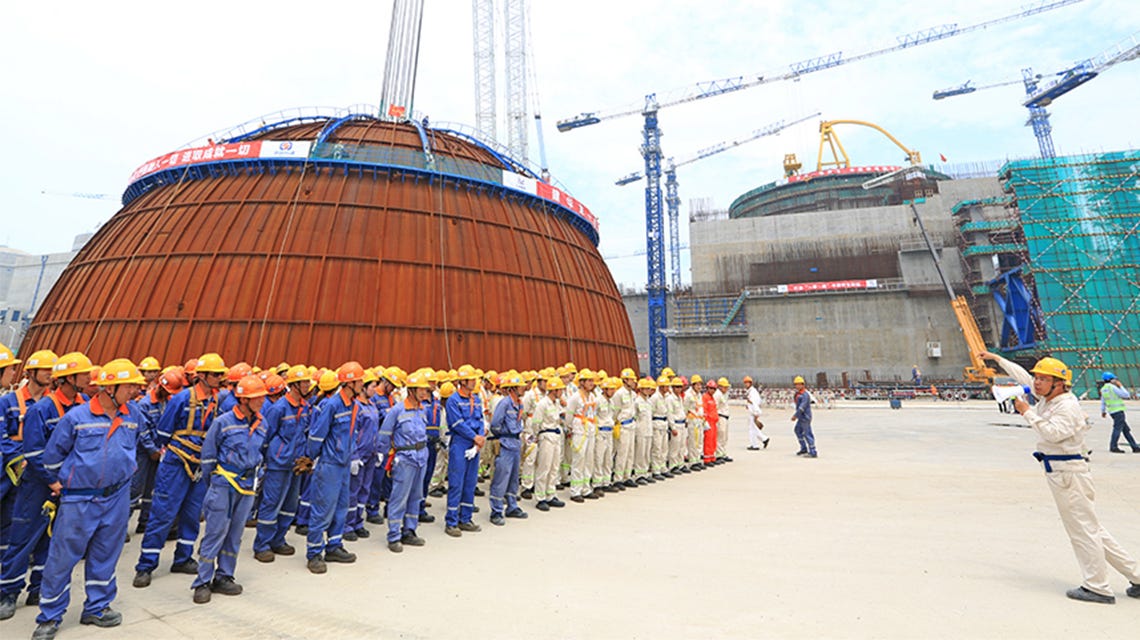Minding the Reactor Gap
China's go nukes vs. America's no nukes
Heard about the “nuclear renaissance”? It’s skipping the United States. Not a single reactor is being built in America.
Meanwhile, a certain frenemy in East Asia is adopting atomic power at an accelerating pace.
There are “23 reactors … under construction in China,” the U.S. Energy Information Administration estimates. The Breakthrough Institute noted that every “commercial-scale reactor project in Chinese history has achieved completion in under a decade.” And the Information Technology and Innovation Foundation observed that since “the start of 2022,” the world’s second-largest economy has pulled off “five domestic reactor builds, with their completion times ranging from just under five years to just over seven years.”
No nation generates more juice from the atom than the Land of the Free. But in the competition to expand zero-emissions, baseload, safe, and dispatchable power, America isn’t much of a player. What gives?
Our nuclear drought can’t be blamed on inadequate “public investment”:
• Under a program launched in 2020, the U.S. Department of Energy (DOE) has awarded tens of millions of dollars “help domestic private industry demonstrate advanced nuclear reactors in the United States.”
• The “Inflation Reduction Act,” signed more than two years ago, includes a “production tax credit” nuclear plants are allowed to tap. Operators of new reactors can choose between a taxpayer-provided freebie of $30 per megawatt-hour “or an investment tax credit of 30%,” which “can rise to as much as 50% if … projects include sufficient domestic content and are built in former coal plant communities.”
• The DOE is a booster of high-assay low-enriched uranium (HALEU), “an important material needed to develop and deploy advanced reactors.” The department’s HALEU Availability Program “is intended to spur demand for additional … production and private investment in the nation’s nuclear fuel supply infrastructure.”
• In July, the president signed a law handing the U.S. Nuclear Regulatory Commission (NRC) “more resources to hire and retain the strong scientific and engineering talent needed to vigorously carry out its mission,” making the bureaucracy better able to “advocate for American nuclear energy in international venues,” and codifying “the timely and efficient licensing of nuclear power as an agency priority.”
• And let’s not forget the DOE’s decades-long statutory and contractual pledges to take out the industry’s trash. The feds promised to acquire, then permanently store, the spent nuclear fuel (SNF) left over by commercial reactors. Yucca Mountain is dead — well, maybe — but the obligation to do something with the stuff remains. The current SNF scheme is “a consent-based approach, driven by community well-being and community needs.”
Nuclear corporatism is nothing new for the United States, of course. In a 1977 piece for The Nation, scientist-activist Bruce L. Welch wrote:
The magnitude of federal commitment to nuclear power is not widely appreciated. The government has given the industry its complex nuclear technology; access to expensive public facilities; free liability insurance; the support of costly research and development; regulatory, emergency and planning programs; low-cost fuel enrichment, waste management and security services; price guarantees, and even direct subsidy.
But after a fast start, America’s grandest “public-private partnership” fizzled. Eight years after Welch compiled his list, Forbes inveighed that the “failure of the U.S. nuclear power program ranks as the largest managerial disaster in business history.” Nukes have never produced more than a fifth of the country’s electricity, and total generation’s been flat, for decades.
A wave of startups is supposed to reverse the trend. TerraPower, Boston Atomics, X-energy, NuScale Power, Deep Fission, Kairos Power, The Nuclear Company — blinkered optimism is reaching levels not seen since the housing bubble, or the dot-com bust. Yet it’s far from clear if D.C. will allow all the newfangled nukes to enter the market. In 2022, the NRC nixed Oklo’s “application to build and operate the company’s Aurora compact fast reactor in Idaho.” The denial caused energy journalist Robert Bryce to lament that as the “U.S. dithers on regulatory matters, China is racing ahead with cutting-edge reactor designs that are safer and more flexible than the reactors now in use.”
The Idaho National Laboratory once explained that a “uranium fuel pellet — roughly the size of the tip of an adult’s little finger — contains the same amount of energy as 17,000 cubic feet of natural gas, 1,780 pounds of coal or 149 gallons of oil.” Making electricity with Element No. 92 is unquestionably smart. What remains in doubt is whether American scientists, engineers, entrepreneurs, and regulators can assemble the financing, technology, and health/safety procedures to finally create power “too cheap to meter.” History suggests that skepticism is warranted.


